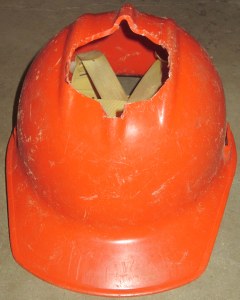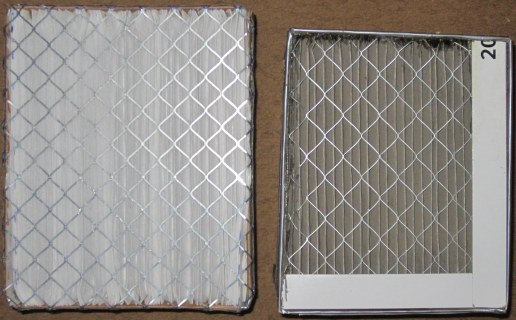Abstract:As of late March 2020, the true nature of the COVID-19 coronavirus transmission vectors remain undetermined (or unpublished)! We have been told that it is transmitted by aerosol and contact transmission, but we have no idea which is more prevalent, nor many details. "Social distancing" is advised/recommended/mandated, but aerosol transmission distances/times remain unproven, nor does that protect one from others who just don't seem to understand that humans are not only the targets of, but the fuel for, a global biological pandemic. Devices such as this home-built PAPR help protect against airborne transmission of the invisible deadly coronavirus.
Knowledge is power. Forewarned is forearmed. Which is another way the federal goverment has once again let Us down: lack of information.
Remember when news first began breaking regarding a potential coronavirus pandemic, and We were told how cell phones, which are frequently touched and brought to the face, were a likely way of becoming infected with the disease?
Well, we don't know anyone who passes their cell phone around they way people pass around money! And it's long been known that paper money can be contaminated by pathogens, as well as by cocaine. And even if you are, for some insane reason, certain that paper money cannot carry and transmit COVID-19, what about when the cashier hands you coins as part of your change? Why have We The People not been adequately warned about this risk? (911U Biology Department recommends carrying a grocery produce bag you saved instead of throwing it away prior to the arrival of COVID-19, and opening it wide when receiving change, for the cashier to drop into the bag, which should be carefully folded closed with opening away from you[r face], and then set aside, untouched, for at least 3~9 days. If you pay with plastic, keep disinfecting it -- preferably before returning it to your wallet.)
Speaking of cashiers, the fact that most of them are currently wearing gloves provides absolutely zero protection against transmission of COVID-19. It is safe to assume that every product on every store shelf is contaminated, and any hand or glove that handles them is also contaminated. We also recommend you decontaminate yourself upon returning from a grocery store, or/and even before getting back into your car, and consider decontaminating the items you purchased before putting them away. You can save the bags the items came in, but we recommend stashing them where they just won't be touched for at least 3~9 days rather than trying to decontaminate them.
But those are all surface contamination concerns. What about when standing in a check-out line, or walking down aisles more crowded with people than products? What can be done to protect one's self from airborne transmission?
For that matter, after coronavirus-carrying aerosols finally fall to the floor, does that mean that we are tracking the cronoavirus into our cars and homes on the soles of Our shoes? Nobody's saying, though the policy at 911U, before the campus shut down, was to spray soles of shoes with 80~85% alcohol when entering a building, and also to wash hands immediately after putting shoes on and taking them off. In other words, just because the governmedia hasn't warned Us about a possible enemy threat does not mean that it does not exist -- a lesson well-learned from our study of 9/11! But I digress...
Before coronavirus-carrying aerosols finally fall to the floor they can be inhaled. They can also hit you in the eye without you knowing it. Trusting other people to remain 6 feet away at all times, and trusting the government that 6' is always a safe distance, may not be enough to protect Us.
On March 21, 2020, ABC news aired video showing health care workers wearing a face shield that was bathing their face in filtered air (they called it a "papper", the first time I heard the term; turns out it's an acronym PAPR, Powered Air-Purifying Respirator):
As soon as I saw one, I wanted one, even though I knew that my having one would deprive a soldier on the front lines of vital battle gear. So the only way to get one was to design/build (well, cobble together) my own. Unfortunately, it turned out that clear curved plastic face shields were nowhere to be found. But by then, it was too late; the wheels were already turning...The campus is shut down already. But I've lived in this house for decades, and I'm enough of a pack rat that all sorts of odds and ends had accumulated down in the basement...
My thinking included somehow utilizing a "chilly bean" battery-powered pocket fan purchased roughly 20 years ago but never used much. It doesn't weigh much, and I felt that its modest flow capacity might be sufficient.
Desktop computers have compact fans with DC motors, too...I'd wanted to pipe (hose) its output to exit behind a face shield. But that would require solving problems related to attaching a hose to the fan for both intake and outflow, plus flow losses from the walls and curves in any hose. And that still did nothing to lend itself to my head. That's when I spotted a plastic safety hard hat that had been lying around, unused, for decades, and it clicked: the hat could be the baffle for the fan, and also hold an air-tight filter housing to provide intake air, like a clunky version of what I'd seen on TV. The inside of the hard hat would be slightly positively pressurized. A small rolled-up towel along its rear opening (behind my head) would cause all the filtered air to exit along the front/sides. And I could hang some kind of face shield from its visor. Only the power source (batteries, in a belt pack, with an on/off switch) would be external to the unit itself. See for yourself...

First test, very promising. As long as filter resistance
is not too great, this is going to work! Wire needs to be
longer, and run between fan & opening before sealing
that gap with quarter-width 2" lengths of duct tape.
Cardboard box is the filter housing.
I cut off the flaps in background
pointing away from the camera. That
opening, nearly 9" x 7", will be filled
with filter material. The oval opening
will be sealed to the hard hat with
half-width 3" and 4" lengths of duct
tape. Be sure to seal all corners and
edges to prevent leakage. Also put duct
tape on the area surrounding the oval.
Note: 1500s filter only 54% of the 0.3~1µm
particles of which N95 masks block 95%!!!
Filtrete 2800 blocks 81%. Use at own risk,
make sure filter material's sealed to housing.
2800 should be better than 1500
unless its resistance is too high.
Once it arrives, I'll try it.
Once I know, you'll know.
material from a dog's post-surgery cone collar
if you don't have one, try CD jewel case covers,
or clear plastic food wrap and a metal coat hanger

print this and stick it on the
sides of the filter housing, so
people will know where to find
this info, without chatting...
April 2020 Update:As soon as I removed the 2800 from its packaging, and was surprised by how heavy it was, I knew it would probably be excessive, in terms of flow resistance, for my little pocket fan. The 2800 is clearly designed for more filtering and less flow. I tried a fan from a PC's power supply, but it ran at 12V and had no better air flow. So I decided to use a larger filter housing, with filter material edge-to-edge this time.

Even though this housing is not quite as tall (height) as the 1500's, I can really feel the extra heft when I move my head side to side. At least the heavier metal mesh can be used to pull the ends of the housing inward against the filter material for better sealing (even before lots of rubber cement is drizzled along that junction). The airflow, which was just adequate with the 1500, is now barely adequate.
Based upon this experience, if you try something like this, you might want to consider using Filtrete 2200, which is rated for about the same flow resistance as the 1500, with fine particle filtering that's closer to the 2800 than to the 1500.
As a matter of fact, given that the Filtrete 1900 traps fine particles better than the 1500 and has lower flow resistance, IMHO, all public buildings (eateries, government buildings, houses of worship, bars, stores...) should be required to run frequently-changed air filters with a rating of MERV 13 (to trap at least 50% of particles between 0.3 and 1 micron) in their ventilation systems. There is nothing magical about 6 feet (of distancing) when (wind or) blower motors are involved... (Have you ever smelled cigarette smoke from more than 6 feet away?)Anyway, the standard solution to this relative lack of airflow would be to throw together a little PWM duty cycle controller, and use it to crank up the power by raising the voltage from 3V to (an average of), say, 3.4V. But that would require a higher supply voltage. And as long as that would be necessary, it seemed like the more elegant though far less sophisticated solution would be to simply use 3 fairly high capacity 1.2V NiMH batteries in place of the 2 1.5V alkaline batteries:
At a shade over 3V, the fan draws 400 mA, free-standing. At 3.6V, drawing air through the 8x10" Filtrete 2800 filter, the faster-spinning motor draws 500 mA. So the 20% increase in voltage (plus increased flow resistance) has added 50% to power consumption, from 1.2 Watts to 1.8W. The NiMH batteries claim a capacity of 2600 mAH (maximum; the fine print 'guarantees' at least 2500), which means they should be able to run the 2800 PAPR for hours -- a theoretical limit of 5 hours -- before needing to be recharged, which is plenty of time to go shopping (amongst strangers during a pandemic) with a lowered health risk.
Plus, these 3 AA batteries weigh considerably less than the 2 1.5V "D" cells I'd been using. And now, for as long as the overworked(?) motor survives, the flow of purified air is once again adequate. The only downside is the increased sound/noise.
Social Distancing, illustrated:
January 22 — March 20, 2020
as of April 8, 2020
comments/inquiries:
site.feedback-Biology{...xX/@\Xx...}911U.org
![]()